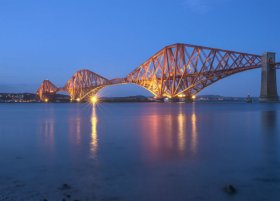UNESCO Scotland
For the last 125 years the Forth Bridge has spanned the Firth of Forth, connecting with Edinburgh. Comprised of 53, 000 tonnes of mild steel – including ten times the amount used to build the Eiffel Tower – this immense red structure with its triple diamond-shaped cantilevers is a indelible part of the east coast skyline.
 The Forth Road Bridge at night viewed from South Queensferry © Kenny Lam / VisitScotland
The Forth Road Bridge at night viewed from South Queensferry © Kenny Lam / VisitScotland
An icon of industrial virtuosity, and of Scotland itself, it is of no surprise that Forth Bridge has been officially inscribed by as Scotland’s sixth World Heritage Site. An accolade that is well overdue we say!
Here is a brief recap of the history of this remarkable rail bridge which has stood gracefully since 1890 and will no doubt continue to do so for many years to come.
Widely hailed as one of the industrial wonders of the world, at the time of its construction the Forth Rail Bridge was one of the most daring engineering feats ever attempted. It took more than 4, 500 men to build it and eight years to complete.
It stretches two and half kilometers between the villages of South Queensferry and North Queensferry, making it the world’s longest cantilever bridge and Britain’s first all-steel bridge. Originally built to carry steam locomotives, the bridge remains as busy as ever with over 200 trains travelling over it daily. In 2002 a major decade-long restoration commenced to return the bridge to tip-top condition with a gob-smacking 240, 000 litres of paint used in its first-ever repainting.
Along with its equally splendid sister, the Forth Road Bridge, it won’t be long until it is joined by a third bridge, the, due to open in 2016. At a length of 2.7 km, it will be the longest three-tower, cable-stayed bridge in the world.
Together, this awesome trio not only chart the evolution of engineering, but are a world-beating example of technological ingenuity and ambition.









